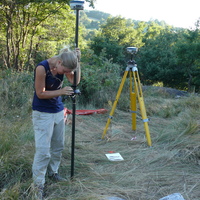- University of Southampton, Archaeological Computing, Graduate Studentadd
- Deep Learning, Remote sensing and GIS applications in Landscape Research, Machine Learning, LiDAR, Artifical Intelligence, Geographic Information Systems (GIS), and 22 moreArtificial Neural Networks, Landscape Archaeology, OBIA (Object Based Image Analysis), Archaeological GIS, Geophysical Survey, Spatial analysis (Archaeology), Statistical Methods in Archaeology, LiDAR for Landscape Archaeology, Semantic Web Technologies, Roman Archaeology, 3D GIS, Geoarchaeology, Ancient Networks, Roman Trade Networks, Archaeology, Classical Archaeology, OBIA, R softwar, Random Forests, Support Vector Machines, Computer Applications & Quantitative Methods in Archaeology (CAA), and Remote Sensing (Archaeology)edit
- PhD student researching 'New Approaches to Archaeology using Deep Learning with Remote Sensor Data'edit
- Jonathon Hareedit
While automated feature recognition is still in its infancy in archaeology, within the geosciences recent developments have allowed its application to much more irregular typology, such as the supervised classification of landslides. This... more
While automated feature recognition is still in its infancy in archaeology, within the geosciences recent developments have allowed its application to much more irregular typology, such as the supervised classification of landslides. This success is largely due to the geographical object-based image analysis software TRIMBLE eCognition. In archaeology, this programme has been applied to some extent, yet new additions to the array of available methods require a re-evaluation of its potential for feature recognition. For instance, the ability to integrate LiDAR data and aerial photography has long been desired within archaeology. Additionally, the ability to transfer rulesets for the detection of common features can facilitate data and knowledge-sharing amongst researchers. The case study will present three different automated detection methods; using the well-known eCognition ruleset generation based on cognitive reasoning; self-learning algorithms; and adaptive template matching. These techniques are applied to round barrow detection in the Avebury region in southern England, specifically distinguishing between the known variations of barrow, bank and ditch. Each method is assessed according to its usability for large regions and its potential for detecting variable features and complex shapes. The algorithms are intended to prioritise cognitive aspects of human vision such as elevation, size, shape and texture, using the LiDAR data and aerial photography. It is also stressed that ruleset exchange for generally known features and processes is highly important for mapping large areas across borders and is intrinsically supported by eCognition.
Research Interests:
The increasing amounts and variety within remote sensing data have triggered researchers to develop semi-automated methods for detecting landscape features. For archaeology it has been recognised that it is difficult to capture the unique... more
The increasing amounts and variety within remote sensing data have triggered researchers to develop semi-automated methods for detecting landscape features. For archaeology it has been recognised that it is difficult to capture the unique characteristics of archaeological remains detected in the landscape. This has led to a discussion of the potential from which was concluded that variable features could not be captured. Nonetheless within geosciences recent success of pattern recognition allowed for the supervised classification of highly irregular landslides using cognitive reasoning and machine learning. These concepts form the basis of artificial intelligence (AI) which has yet to be explored for remote sensing in archaeology. The success in geoscience is largely provided by the geographical object based image analysis software, eCognition, which has been explored by archaeologists to some extent but was not applied in great detail. With the presentation of a pilot study for barrow recognition around Avebury, United Kingdom, it has been shown that the potential of this software is far reaching and requires a re-evaluation within the archaeological discipline for remote sensing. From three basic analysis based on cognitive ruleset, template matching and machine learning it was concluded that the first is simple to implement but requires a lot of manual refinement and with the second, simple and consistent features could be detected. Even though the machine learning algorithm did not yield the best results it is a known fact that with adequate amounts of training data, this is the best method to detect variable features as it writes the rules itself based on similarities between training samples. As it was shown that AI concepts are able to detect unique characteristics of archaeological features and combine multiple remote sensing layers to do so it was found that the future of semi-automated pattern recognition in archaeological remote sensing could greatly aid large scale mapping programmes. Additionally, these methods could be applied for change detection to monitor archaeological sites for improved heritage management and have the potential to be widely implemented in an all-encompassing online web application for exchange of rulesets and training data for generally known features.
